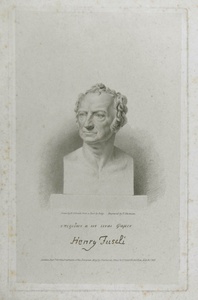| Method | Stipple |
| Artist | T. Thomson after Edward Hodges Baily |
| Published | London, Pubd. for the Proprietors of the European Mag. by Sherwood, Jones & Co. Pater Noster Row, March 1 1825. |
| Dimensions | Image 99 x 106 mm, Plate 223 x 139 mm, Sheet 277 x 203 mm |
| Notes |
From The European Magazine. A stipple of the artist Henry Fuseli, after the bust by Edward Hodges Baily. The bust faces the front, the head turned slightly to the left. The portrait captures Fuseli's characteristic gaze perfectly, and despite the fact that this bust was taken late in the artists life, the intensity of his facial expression is little changed from the dramatic portrait of the young Fuseli by Northcote. Below the portrait is a transcription of the dedication Fuseli suggested be added to the bust in Greek, 'Look upon that which we now suppose to be.' Henry Fuseli (7th February 1741 - 17th April 1825) was a Swiss-born Britain-based painter, draughtsman, art critic, and academic. A key early figure of the British Romantic art movement, he was a major source of inspiration for the young William Blake. Fuseli was the son of the painter Johann Kaspar Füssli, who intended that his son become a clergyman. From his early religious training, Fuseli gained a thorough education in classical, biblical, and germanic history, mythology, and art, and the influence of this is clear in his works. He travelled extensively in Italy before settling in London, where he almost immediately established his reputation with heroic scale paintings of scenes from the works of Shakespeare for Boydell's Shakespeare Gallery. Boydell's success inspired Fuseli to attempt his own Milton Gallery, for which he began a series of very large paintings of scenes from Paradise Lost, though the project never came to fruition. Fuseli's contribution to Romanticism came in his flair for the dramatic, and his ability to capture the turmoil, chaos, and desolation of his subjects. His paintings reveal a master of chiaroscuro, and his most famous gothic work, The Nightmare, is the perfect encapsulation of his love of the supernatural. Indeed, Fuseli's own temperament was appropriately Romantic. During his time in Italy, it was reported that he would sit by the window at night, deep in contemplation, his figure framed by the flash of lightning or the encroaching dark. His career as an essay writer and art critic also placed him in the same social circles as the political philosophers William Godwin and Mary Wollstonecraft, the parents of Mary Shelley. T. Thomson (fl. 1820s) was a British engraver. Edward Hodges Baily RA FRS (10 March 1788 - 22 May 1867) was a British sculptor. His early work predominantly focussed on biblical and classical figural groups, though in later life he mainly worked on portrait busts and public monuments. Among his most notable works are the bas reliefs on the sides of Marble Arch in Hyde Park, and the statue of Nelson in Trafalgar Square. O'Donoghue 2. Condition: Foxing to sheet. |
| Framing | unmounted |
| Price | £80.00 |
| Stock ID | 36362 |

